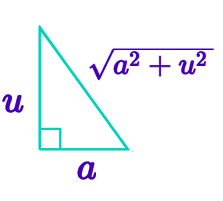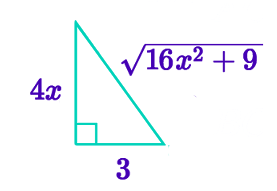For an integral of the general form
#intsqrt(a^2+u^2)du#
To integrate using the method of trigonometric substitution, set #u=atantheta, du=asec^2theta#. Then, #sectheta=sqrt(a^2+u^2)/a# and #asec(theta)=sqrt(a^2+u^2)#. This can be visualized by drawing a triangle.

Explanation: As stated above, we know that #u=atantheta#, so #tantheta=u/a#. Since #tantheta# is #y/x#, we can place #u# along the opposite side of the triangle and #a# along the adjacent side. By the Pythagorean theorem, #a^2+b^2=c^2#, and so the hypotenuse of the triangle must be #sqrt(a^2+u^2)# in terms of #a# and #u#.
We then substitute back into the original integral using the appropriate trigonometric functions, using the triangle as a guide. The integral is then solved, and we substitute back in for our trigonometric functions in terms of our original variables. However, this particular integral will involve an extra step, which makes it a little more tricky.
#intsqrt(9+16x^2)dx#
- #4x=3tantheta=>x=3/4tantheta#, #dx=3/4sec^2thetad theta#
You now have two options as to how to proceed from here. You may either directly substitute into the original integral using these definitions for #x# and #dx#, or you can set up the triangle. Both methods will work and in the end may take about the same amount of time (depending on complexity of problem) but setting up the triangle may lessen the possibility of making algebraic mistakes when you simplify and possibly eliminate the need to use trig. identities. This will be clear below.
Method 1: Substitute Directly
#intsqrt(9+16x^2)dx=>intsqrt(16((3tantheta)/4)^2+9)*3/4sec^2thetad theta#
Note: do not forget to replace #dx# with #3/4sec^2thetad theta#.
Simplifying:
#=>intsqrt(16*(9tan^2theta)/16+9)*3/4sec^2theta d theta#
#=>intsqrt(9tan^2theta+9)*3/4sec^2theta d theta#
Factor out #9#
#=>intsqrt(9(tan^2theta+1))*3/4sec^2thetad theta#
Use trig. identity: #tan^2theta+1=sec^theta#
#=>intsqrt(9sec^2theta)*3/4sec^2thetad theta#
#=>int3sectheta*3/4sec^2thetad theta#
#=>9/4intsec^3thetad theta#
Method 2: Triangle

From the triangle, we see that #tantheta=(4x)/3# and #3sectheta=sqrt(16x^2+9)=>sectheta=(sqrt(16x^2+9))/3#
We can then substitute into our original integral:
#intsqrt(9+16x^2)dx=>int3sectheta*3/4sec^2thetad theta#
#=>9/4intsec^3thetad theta#
- Now the goal is to solve this trigonometric integral in place of the original. Use integration by parts.
#uv-intvdu#
#u=sectheta, du=secthetatanthetad theta#
#dv=sec^2thetad theta, v=tantheta#
#=>9/4[secthetatantheta-inttan^2thetasecthetad theta]#
Use trig. identity: #tan^2theta+1=sec^2theta#
#=>9/4[secthetatantheta-int(sec^2theta-1)secthetad theta]#
#=>9/4[secthetatantheta-intsec^3theta-secthetad theta]#
Breaking up the integral...
#9/4[secthetatantheta-(intsec^3d theta-intsecthetad theta)]#
#=>9/4[secthetatantheta-intsec^3d theta+intsecthetad theta]#
- Here is the extra step. Remember that we are attempting to integrate #9/4sec^3theta#. Therefore, at this point:
#9/4intsec^3d theta=9/4[secthetatantheta-intsec^3d theta+intsecthetad theta]#
Cancel #9/4#
#=>intsec^3d theta=secthetatantheta-intsec^3d theta+intsecthetad theta#
Add #intsec^3thetad theta# to the left side.
#=>2intsec^3thetad theta=secthetatantheta+intsecthetad theta#
Divide both sides by #2#
#=>intsec^3thetad theta=1/2(secthetatantheta+intsecthetad theta)#
- We now have an answer to what #intsec^3thetad theta# is, but remember we were trying to integrate #9/4intsec^3thetad theta#, so multiply by #9/4#.
#=>9/4(1/2)(secthetatantheta+intsecthetad theta)#
#=>9/8(secthetatantheta+intsecthetad theta)#
Integrate #sectheta#
#=>9/8(secthetatantheta+ln|sectheta+tantheta|)#
- Now replace the trig. functions with original variables. Above, we used the triangle to obtain these definitions:
#tantheta=(4x)/3# and #sectheta=(sqrt(16x^2+9))/3#
And so,
#=>9/8[((sqrt(16x^2+9))/3*(4x)/3)+ln|(sqrt(16x^2+9))/3+(4x)/3|]#
Simplify:
#=>(4xsqrt(16x^2+9)+9ln|(sqrt(16x^2+9))/3+(4x)/3|)/8+C#
#=>(4xsqrt(16x^2+9)+9ln|(sqrt(16x^2+9)+4x)/3|)/8+C#
Hope this helps!



